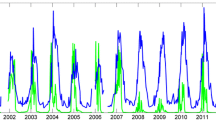Abstract
Tilapia mossambica (Teleostei) weighing 5 to 80 g were acclimated at 30°C to salinities of 0.4‰ (tap water), 12.5‰ (50% sea water) and 30.5‰ (100% sea water). Their respiration was measured at routine activity and the partial pressure of ambient oxygen gradually reduced from 250 to 50 mm Hg. Respiration is salinity-dependent; the proportionate ability to use oxygen in any one salinity is — above the critical pO2 —the same in all experimental groups. This ability is a function of temperature and increases from 15° to 30°C, becoming temperature independent from 30° to 40°C as long as the pO2 remains above 150 mm Hg. At 50 mm Hg pO2, the limiting effect of oxygen causes a decrease in metabolic rate. This limiting effect is minimal in 80 g fish kept in an isotonic medium (12.5‰ S), allowing greater scope for activity and a higher rate of oxygen uptake.
Similar content being viewed by others
Literature cited
Brett, J. R.: Rate of gain of heat tolerance in goldfish Carassius auratus Univ. Toronto Studies Biol. Ser. 52 [=Publs Ont. Fish. Res. Lab. 64, 9–28] (1946).
—: Implications and assessments of environmental stress. In: The investigation of fish-power problems, pp 69–83. sEd. by P. A. Larkin, H. R. Labkin MacMillan Lectures in Fisheries. Vancouver, Can.: Univ. British Columbia 1958.
Dehnel, P. A.: Effect of temperature and salinity on the oxygen consumption of two intertidal crabs. Biol. Bull. mar. biol. Lab., Woods Hole 118 (2), 215–249 (1960).
Fry, F. E. J.: Effects of the environment on animal activity. Univ. Toronto Studies Biol. Ser. 55 [=Publs Ont. Fish. Res. Lab. 68, 1–62] (1947).
Job, S. V.: The oxygen consumption of Salvelinus fontinalis. Univ. Toronto Studies Biol. Ser. 61 [=Publs Ont. Fish. Res. Lab. 73, 1–39] (1955).
—: The routine active oxygen consumption of the milk fish. Proc. Indian Acad. Sci. 45 Sect. B (6), 302–313 (1957).
—: The metabolism of Plotosus anguillaris in different concentrations of salt and oxygen in the medium. Proc. Indian Acad. Sci. 50 Sect. B (5), 267–288 (1959).
—: The respiratory metabolism of Tilapia mossambica (Teleostei) I. The effect of size, temperature and salinity. Mar. Biol. 2, 121–126 (1969).
Kinne, O.: Growth, food intake and food conversion in a euryplastic fish exposed to different temperatures and salinities. Physiol. Zoöl. 30, 288–317 (1960).
—: The effect of temperature and salinity on marine and brackish water animals. II. Salinity and temperature-salinity combinations. Oceanogr. mar. Biol. A. Rev. 2, 281–339 (1964).
Parvatheswararao, V.: Influence of temperature salinity combinations on the oxygen consumption in the freshwater fish Etroplus maculatus (Teleostei). Helgoländer wiss. Meeresunters. 12, 301–314 (1965).
Author information
Authors and Affiliations
Additional information
Communicated by N. K. Panikkar, New Delhi
Rights and permissions
About this article
Cite this article
Job, S.V. The respiratory metabolism of Tilapia mossambica (Teleostei). Marine Biology 3, 222–226 (1969). https://doi.org/10.1007/BF00360954
Accepted:
Issue Date:
DOI: https://doi.org/10.1007/BF00360954




